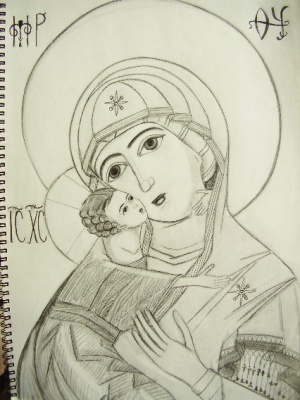Difference between revisions of "Panagia Eleousa"
m |
m (fix Category) |
||
| (2 intermediate revisions by one other user not shown) | |||
| Line 1: | Line 1: | ||
| − | [[Image: | + | [[Image:Panagia_Eleousa.JPG|thumb|right|Sketch of the Virgin of Tender Mercy ("Eleousa") by Ms. Paraskevi Dellis]] |
| − | '''Panagia Eleousa''' is an [[icon]] known as the Virgin of | + | '''Panagia Eleousa''' (Gr. ''ελεούσα'') is an [[icon]] known as the '''Virgin of Tenderness''' or ''showing mercy'' and is often compared to the [[Panagia Glykophilousa|Virgin of ''Loving Kindness'']] or the [[Panagia Hodegetria|''Hodegetria'']] type icons. |
| − | The difference from the first icon is that in the Eleousa, the Child Christ touches his mother's face and wraps one arm around her neck or shoulder. The mutual gestures of loving kindness between the Theotokos and her child give this icon a warmth and tenderness though the sentimentality is not excessive and retains a noble quality. The personal pain and grief in the face of the Theotokos can be felt and transformed into a universal grief and pain for the present life. In the Hodegetria, the emphasis is on the divinity of Christ, whereas, in this icon, the emphasis is on the humanity of Christ and the compassion of the Theotokos are emphasised as a motherly compassion for all human beings. | + | The difference from the first icon is that in the ''Eleousa'', the Child Christ touches his mother's face and wraps one arm around her neck or shoulder. The mutual gestures of loving kindness between the Theotokos and her child give this icon a warmth and tenderness though the sentimentality is not excessive and retains a noble quality. The personal pain and grief in the face of the Theotokos can be felt and transformed into a universal grief and pain for the present life. In the Hodegetria, the emphasis is on the divinity of Christ, whereas, in this icon, the emphasis is on the humanity of Christ and the compassion of the Theotokos are emphasised as a motherly compassion for all human beings. |
| + | |||
| + | Well known examples of this type of icon include the: | ||
| + | * [[Theotokos of Vladimir]] | ||
| + | * Our Lady of Pochayiv (''Pochaevskaya''), 16th-century | ||
==External link== | ==External link== | ||
*[http://www.windowseternal.com/eleousa.html Window to the Eleousa symbolism] | *[http://www.windowseternal.com/eleousa.html Window to the Eleousa symbolism] | ||
| − | + | [[Category:About Icons]] | |
| − | |||
| − | |||
[[Category:Icons of the Theotokos]] | [[Category:Icons of the Theotokos]] | ||
[[Category:Theotokonymia]] | [[Category:Theotokonymia]] | ||
Latest revision as of 13:59, July 28, 2008
Panagia Eleousa (Gr. ελεούσα) is an icon known as the Virgin of Tenderness or showing mercy and is often compared to the Virgin of Loving Kindness or the Hodegetria type icons.
The difference from the first icon is that in the Eleousa, the Child Christ touches his mother's face and wraps one arm around her neck or shoulder. The mutual gestures of loving kindness between the Theotokos and her child give this icon a warmth and tenderness though the sentimentality is not excessive and retains a noble quality. The personal pain and grief in the face of the Theotokos can be felt and transformed into a universal grief and pain for the present life. In the Hodegetria, the emphasis is on the divinity of Christ, whereas, in this icon, the emphasis is on the humanity of Christ and the compassion of the Theotokos are emphasised as a motherly compassion for all human beings.
Well known examples of this type of icon include the:
- Theotokos of Vladimir
- Our Lady of Pochayiv (Pochaevskaya), 16th-century
External link
Categories > Arts
Categories > Arts
Categories > Church Life > Theotokonymia
Categories > Church Life > Theotokonymia > Icons of the Theotokos
Categories > Images > Icons
Categories > Liturgics > About Icons
Categories > Liturgics > About Icons
Categories > Liturgics > Feasts
Categories > Liturgics > Feasts
